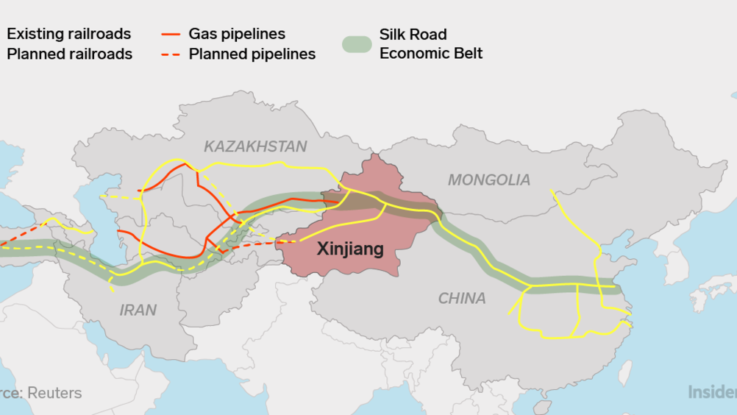
China is a highly authoritarian state with an extremely poor record on human rights. During the 2000s, it seemed like the country was very slowly and tentatively liberalizing. This is no longer the case. The cumulative weight of the color revolutions and the Arab spring seems to have convinced Beijing, like many other authoritarian regimes, that the possibility of revolutionary surprises is both real and dangerous. Xi Jinping has decided to move the country in a more autocratic direction, consolidating power in his own hands, shutting down the nascent spaces of greater political freedom
What’s sometimes less appreciated is that the structure of the Chinese state also has significant imperial characteristics. Xinjiang, where China has placed at least a million ethnic Uighurs in “reeducation camps,” has long been the site of settler colonialism. Beijing encourages the migration of Han Chinese into the province with the aim of shifting its demographic balance. Indeed, many observers point to 2009 ethnic riots as the ultimate cause of the current crackdown, even as some contend that concern over the Belt and Road Initiative also played a key role.
The policies adopted in Xinjiang have an immediate precedent in Tibet. There, the government has also sought to aggressively shift the demographic balance through Han migration and otherwise pursued a strategy of Sinicization. In fact, the current party secretary of Xinjiang, Chen Quanguo, previously held the same position in Tibet.
Recently, the New York Times reported that Sinicization pressures on Muslims in China are spreading beyond Xinjiang.
That tide of “Sinicization,” as Chinese policymakers call it, is surging nationwide. A recent, unescorted trip through Gansu, a corridor that once ushered Silk Road caravans and Islam into imperial China, revealed an accelerating campaign to assimilate another Muslim minority, the Hui, a Chinese-speaking people with no recent record of separatism or extremism.
The campaign targeting the Hui does not feature mass internment or pervasive digital surveillance, the most striking aspects of the Xinjiang crackdown. But it is a purge of ideas, symbols, culture, products — anything deemed not Chinese. It permeates life, in ways existential and mundane.Domes and minarets are lopped off mosques and replaced with curving Chinese roofs. News broadcasts are forbidden to show pedestrians wearing traditional Hui skullcaps or veils. Arabic script is outlawed in public spaces, so practically every restaurant has a sun-beaten facade with dark traces where the word “halal” has been scraped off.
Strict new quotas throttle religious education to the degree that some Hui intellectuals predict their people could become largely irreligious, like most of China, in two or three generations.
Pressures are mounting against the Hui, the distant descendants of Persian traders, at a moment when the Communist leadership is stoking nationalism among the ethnic majority Han to bolster popular support. In officials’ speeches, on television and across billboards, one frequent refrain is the “China Dream” — Xi’s vision of restoring China’s historic power and wealth, its culture and its pride.
In many ways, Chinese policy is essentially a twenty-first century variant of well-rehearsed imperial control strategies. Many empires exploit difference via divide-and-rule tactics—essentially maintaining control by setting populations against one another. Indeed, imperial systems are one of three major ways that human beings have worked out to handle ethnically diverse and territorially expansive polities. The other two are federal and confederal systems, and many political communities mix elements of all three.
Over time, particularly durable and successful empires can produce increasing homogenization via the spread of common language and cultural practices. Both the Romans and successive Chinese dynasties transformed many of the peoples who came under the writ.
But empires can also see diversity as a problem, especially when rulers either can not or will not—often for ideological or religious reasons—tolerate the persistence of subpopulations that they consider threatening. In those circumstances, they may turn toward ethnic cleansing via some combination of mass murder, forcible relocation, and coercive assimilation.
Many modern “nations” are the product of these kinds of processes, whether in their their violent or non-violent variants. For instance, compare how the United States treated many Native Americans, especially during processes of westward imperial expansion and their aftermath.
The example of the United States is particularly useful, in that nineteenth-century America was something of a transitional or hybrid polity. Its continental imperial territories became federal units, and it bootstrapped a national-state onto a federative system.
Indeed, the development of naitonal-states was almost always marked by decreasing tolerance of pluralism. Heather Rae argues that this often amounted to “pathological homogenization”, in which rulers pursue the elimination of ethnic and religious differences even when doing so is more costly than allowing pluralism to persist. They do so, she argues, primarily out of concerns for their legitimacy.
Which brings us back to contemporary China. China combines elements of national-states, imperial systems, and federations. China has historically been too large and diverse to govern without the significant use of imperial logics of organization and of imperial repertoires. Like some of its more recent forebears, Beijing harnesses the more expansive toolkit of industrial society to pursue homogenization and control. At the same, China is engaged in a grand experiment to see if the techniques of digital authoritarianism can augment these efforts.
The current Chinese model also seeks to cope with other institutional tensions. These include ones between imperial modes of control—which depends on the segmentation of territorial units to hinder the spread of political contention—and an increasingly integrated capitalist economy—which facilitates the flow of peoples and ideas across territorial units.
At the same time, we would normally expect Beijing’s targeting of Muslims throughout China to present a particular political risk, insofar as it activates common grievances across different ethnic groups spread across multiple regions. It makes “Muslim identity” much more politically salient—an identity that Chinese Muslims share with nearly a quarter of the world’s population.
But it seems that Beijing believes some combination of the following:
- its mechanisms of social control are sufficiently robust to minimize the downside risks;
- The existing threat posed by its Muslim communities is great enough to justify those downside risks;
- The legitimacy gains from targeting its Muslim populations are great enough to justify those downside risks; and
- Its economic power is sufficient to reduce international costs, whether in terms of China’s reputation or blowback from the Muslim world.
So far, these calculations appear correct. Certainly, China has done a fairly effective job of insulating itself on the international stage.
When Turkey’s leader, Recep Tayyip Erdogan, visited Beijing this summer, he hailed a new Silk Road bridging Asia and Europe. He welcomed big Chinese investments for his beleaguered economy. He gushed about China’s sovereignty.
But Mr. Erdogan, who has stridently promoted Islamic values in his overwhelmingly Muslim country, was largely silent on the incarceration of more than one million Turkic Muslims in China’s western region of Xinjiang, and the forced assimilation of millions more. It was an about-face from a decade ago, when he said the Uighurs there suffered from, “simply put, genocide” at the hands of the Chinese government.
Like Mr. Erdogan, the world has been noticeably quiet about Xinjiang, where China has built a vast network of detention camps and systematic surveillance over the past two years in a state-led operation to convert Uighurs into loyal, secular supporters of the Communist Party. Even when diplomats have witnessed the problems firsthand and privately condemned them, they have been reluctant to go public, unable to garner broad support or unwilling to risk financial ties with China.
Backed by its diplomatic and economic might, China has largely succeeded in quashing criticism. Chinese officials have convinced countries to support Beijing publicly on the issue, most notably Muslim ones in Africa, Asia and the Middle East. They have played to the discord within the West over China. And they have waged an aggressive campaign to prevent discussion of Xinjiang at the United Nations.
All of this provides, in my view, clear evidence that transformation in international order is already underway. The question for the United States is how to adapt.

